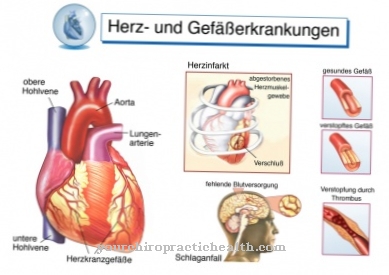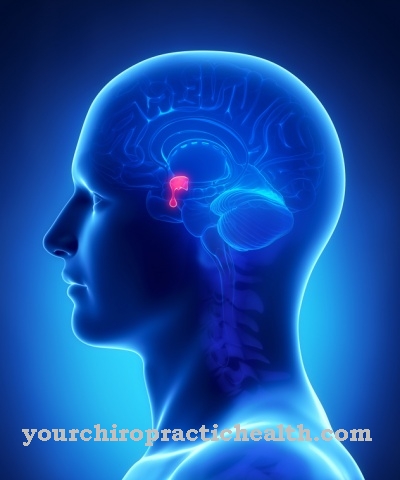As catatonia medicine knows a psychomotor complex of behavioral, emotional and motor symptoms. Catatonic symptoms can arise in schizophrenia, depression and neurological diseases. If drug treatment fails, electroconvulsive therapy is performed.
What is catatonia?

© Goss Vitalij - stock.adobe.com
The catatonia is a psychomotor syndrome that can occur in the context of severe depression, catatonic schizophrenia or metabolic disorders and neurological diseases. The syndrome was first described in the 19th century by Kahlbaum, who linked it as a symptom complex with depression. Kraepelin and Bleuler later described catatonia as a sub-form of schizophrenia.
A special form of catatonia is pernicious or malignant catatonia, which, if left untreated, can assume life-threatening proportions. In addition to depressive and schizophrenic states, arousal can also be catatonic. This catatonic excitation is also known as the catatonic raptus and expresses itself contrary to the catatonic depression. In all cases of catatonia, the patients show symptoms on an emotional level as well as behavioral problems and physiological restrictions, which mainly affect motor skills.
Kahlbaum, who first described it, described the complex as a mental and muscular state of tension that can be triggered by depression. Today medicine knows that catatonia is not directly related to a specific diagnosis.
causes
The causes of catatonia are many. The syndrome can arise, for example, in the context of primary diseases such as AIDS. Especially in the neurological form of the disease, patients often show catatonic features. Other neurological diseases are also possible causes. In this case, a physiological change in brain tissue causes the symptoms.
Alcohol consumption or the influence of drugs can also trigger catatonia. Another possible cause is a metabolic disorder. If schizophrenia triggers catatonia, then environmental, genetic, and psychodynamic components are likely to play together. If depression can be found to be the cause of catatonia, the main causes are losses, stress and excessive demands.
Traumatic childhood experiences and biochemical changes in the brain are also discussed as causes. The same applies to drugs, which in turn can cause catatonia themselves. Catatonic syndrome can also occur as part of a dissociative neurotic disorder.
Symptoms, ailments & signs
In catatonia, the entire body cramps into a state of tension with increased muscle tone. The patients remain in a rigid position that is held for several hours. They usually participate in passive movements, maintaining the body position for hours after the movement. Waxy muscle resistance is evident during passive movement. In addition, there is usually mutism.
This means that those affected no longer speak or only repeat what they have heard. In this context, there is also talk of an echolalia. Some patients mainly repeat words and phrases that have a special sound and, for example, rhyme. What is asked of them, catatonic people either do mechanically or they practice negativism.
In doing so, they are doing the exact opposite of what was asked of them. In the case of catatonic schizophrenia, symptoms can range from tremendous arousal to extreme passivity. In the case of catatonic arousal, for example, the patients throw themselves on the floor, make faces and display aimlessly aggressive behavior. The voluntary movements are angular and disharmonious.
Diagnosis & course of disease
The doctor makes the diagnosis of catatonia primarily through observation and passive movements. An MRI may be required to rule out neurological disorders as the cause. When taking the anamnesis, the doctor will find out whether there have been any psychological abnormalities in the past. With this knowledge, he assesses catatonia in the context of a primary disease.
Complications
The catatonia leads to various complaints. Those affected suffer from severe psychological stress and motor restrictions, which significantly reduce the quality of life of the person concerned. Those affected may also need the help of other people in their everyday lives.
The patient's body is very tense and strained, so that there is often no relaxation. Likewise, the muscles can no longer be moved easily and the patients can no longer speak properly. It is not uncommon for other people to repeat what they have spoken. Furthermore, the catatonia can lead to aggressive behavior.
Therefore, in some cases, the treatment of this disease must also take place in a closed clinic. Self-harming behavior can also occur. The neurological restrictions often cause breathing difficulties or fever.
The treatment of catatonia proves to be relatively difficult, since the psychological complaints in particular cannot be completely restricted in every case. Often the patient cannot be completely cured. Should epileptic seizures occur, these must also be restricted. The life expectancy of the person affected may be shortened.
When should you go to the doctor?
Catatonia is a special emergency medical case. If an affected person shows the symptoms of catatonia, an emergency doctor must be alerted and first aid measures initiated. If people show stiffness all over their bodies, they urgently need medical attention. If an unnatural posture of the body is observed, which has a frightening effect on outsiders, no part of the body can be moved willingly, a doctor should be called. If the person concerned is suddenly no longer able to speak or to react sensibly to direct contact, he needs medical care as soon as possible.
If there is a slowed reaction to instructions or if the opposite of what is requested is carried out, these are indications of existing health irregularities. Some patients speak in rhymes or with a special rhythm of sound in a state of catatonia. Since only medically trained personnel can react in a sufficient manner to the condition of the catatonia and the existing underlying disease, the presence of a doctor is necessary immediately.
Those affected often remain in a stiff position for several hours and cannot take in any food or sufficient fluids to supply the organism. A doctor should be contacted within minutes after the onset of catatonia. If movements are initiated from outside, the patient's muscles are often perceived as waxy.
Treatment & Therapy
The catatonia can reach life-threatening proportions. The patients ingest neither food nor fluids. Therefore, catatonic phenomena must be reacted to as quickly as possible. If left unchecked, catatonia can escalate into malignant catatonia. A high fever occurs with no signs of inflammation or infectious symptoms. As part of this phenomenon, muscle tension destroys the muscles bit by bit.
In addition, vegetative dysregulations can occur, which for example result in respiratory insufficiency. So that the patient is spared this life-threatening form of catatonia, the attending physician conducts psychopharmacological therapy. This therapy corresponds primarily to the administration of GABA-ergic substances. If a mental disorder is suspected to be the cause, the primary disease is also specifically treated. In the case of schizophrenia, neuroleptics are given for this purpose.
In the case of depressive disorders, on the other hand, patients are treated with antidepressants. If these measures fail and the catatonia does not resolve despite all efforts, electroconvulsive therapy is performed. Under anesthesia, the patient is given electrical impulses that last for several seconds. The impulses trigger a minimal epileptic seizure. Electroconvulsive therapy is usually performed eight to twelve times within two to three days.
You can find your medication here
➔ Medicines to calm down and strengthen nervesOutlook & forecast
Catatonia is a life-threatening condition for the patient. In severe cases, the affected person dies prematurely, as important vital functions cannot sufficiently take place in this physical condition. Without intensive medical care as soon as possible, the person affected has little chance of alleviating their existing symptoms. Complications and secondary diseases are to be expected which lead to a severe impairment of the quality of life.
Even with the fastest possible medical care, long-term impairments and health disorders are to be expected. Catatonia is a symptom of an existing underlying disease. This is usually severe and can only be treated with long-term therapy. In many cases, the person concerned has a permanent or long-term clinical stay because of a mental disorder. The patient is not able to organize his or her life independently. The existing symptoms do not allow this even after coping with a catatonia.
Due to the present cause of catatonia, the overall condition of the affected person must always be taken into account when making a prognosis. Although the muscle tension has been successfully managed and the state of health has stabilized, the patient cannot be released from treatment as having recovered. Further follow-up treatments and daily medical attention are necessary for people who have suffered from catatonia.
prevention
The causes of catatonia are varied. Although intoxication-related catatonia can perhaps be prevented, neurological catatonia in particular cannot be prevented.
Aftercare
In most cases of catatonia, those affected have very few and only very limited measures and options for direct follow-up care. First and foremost, a quick and, above all, an early diagnosis must be made in order to prevent the occurrence of other complications and complaints. There can also be no self-healing.
Most of those affected depend on the intake of various medications in order to relieve the symptoms permanently and properly. You should always pay attention to a regular intake and also to a correct dosage in order to limit the symptoms permanently. If anything is unclear or if you have any questions or side effects, a doctor should always be contacted first.
Likewise, many of those affected by catatonia depend on the help of their own family in everyday life to alleviate the symptoms. Loving conversations have a positive effect on the course of the disease and can also prevent depression and other psychological upsets. The disease may also reduce the life expectancy of the person affected, as it cannot always be completely cured. Contact with other patients can also be useful.
You can do that yourself
In the case of catatonia, the patient has no options to help himself or to optimize his everyday life due to the symptoms. The body cannot be moved and consequently no changes can be made in this state that contribute to an improvement in general well-being.
The patient is dependent on medical care from doctors, relatives or nursing staff. Within the scope of their possibilities, they can implement little things in the design of everyday life for the sick person. Since the relatives of a patient are often emotionally overwhelmed by the situation, they often need help and support in everyday life. You can join a support group for loved ones. There you have the opportunity to intensively exchange your own feelings and experiences with other people affected. This contributes to an emotional relief. In a self-help group, relatives can count on mutual support and receive tips on how to deal with the situation.
It is also advisable to use relaxation techniques. With proven methods such as yoga, meditation, autogenic training or breathing techniques, relatives can reduce stress and at the same time gain new strength to cope with everyday life. Whenever possible, you should not manage the care of someone with catatonia on your own.



.jpg)
.jpg)







.jpg)



.jpg)










.jpg)
